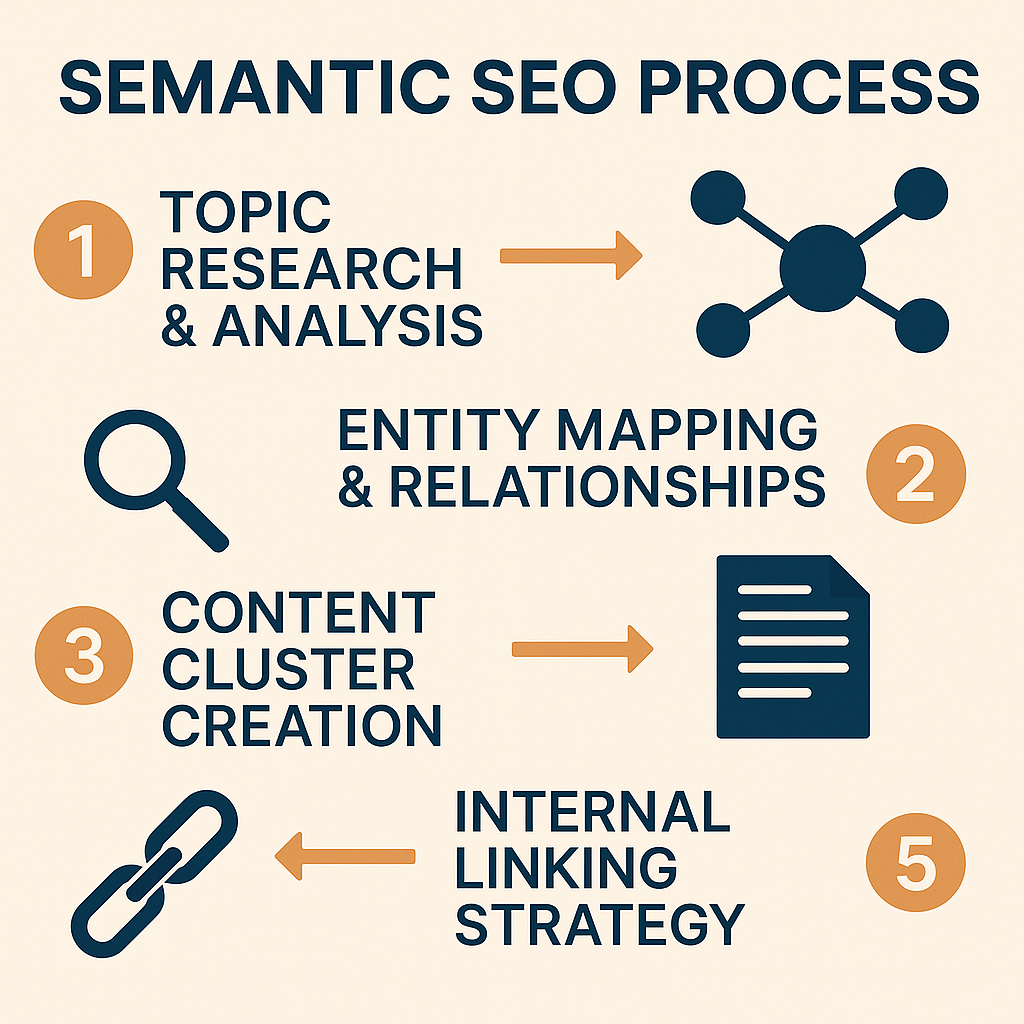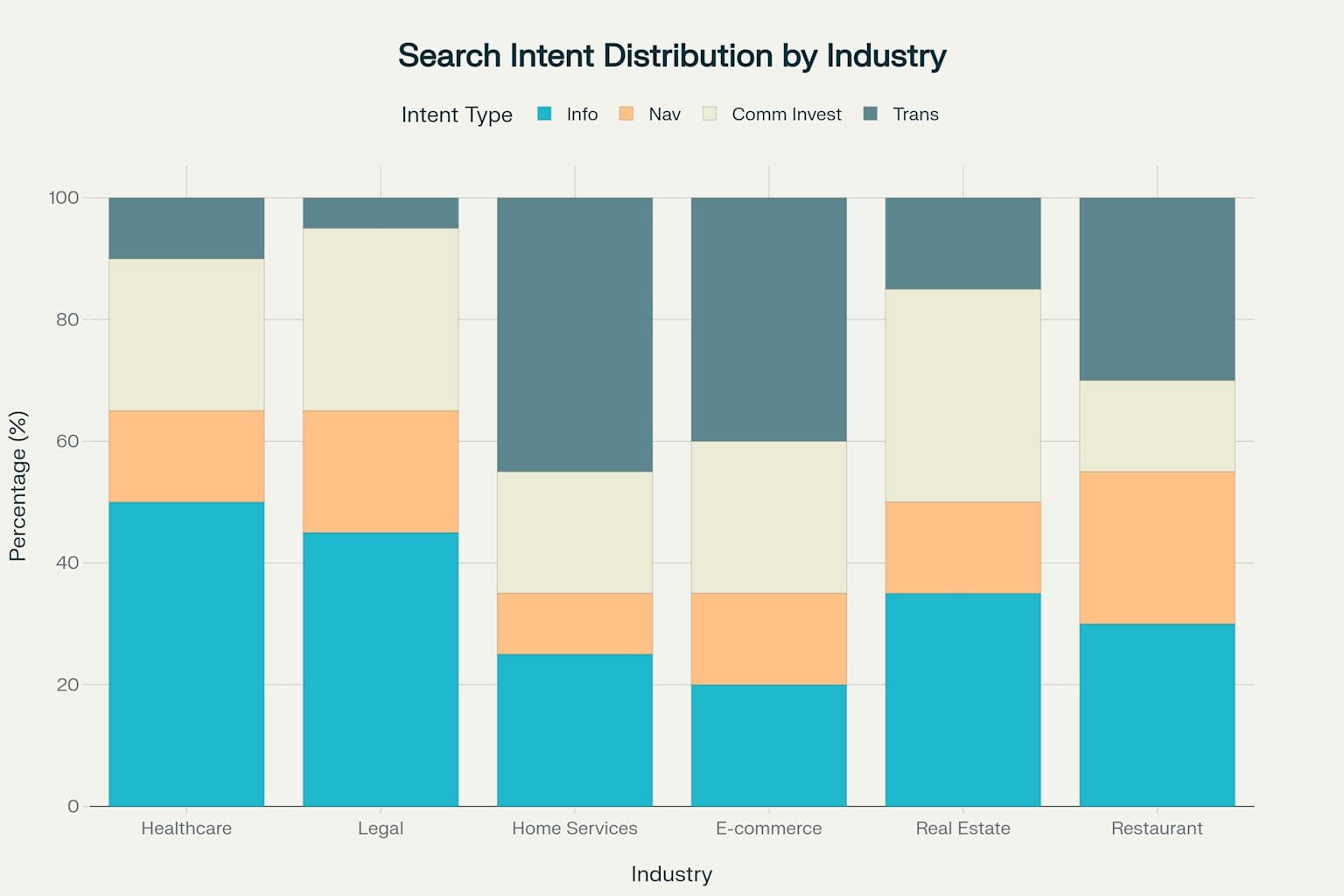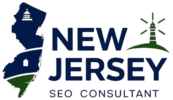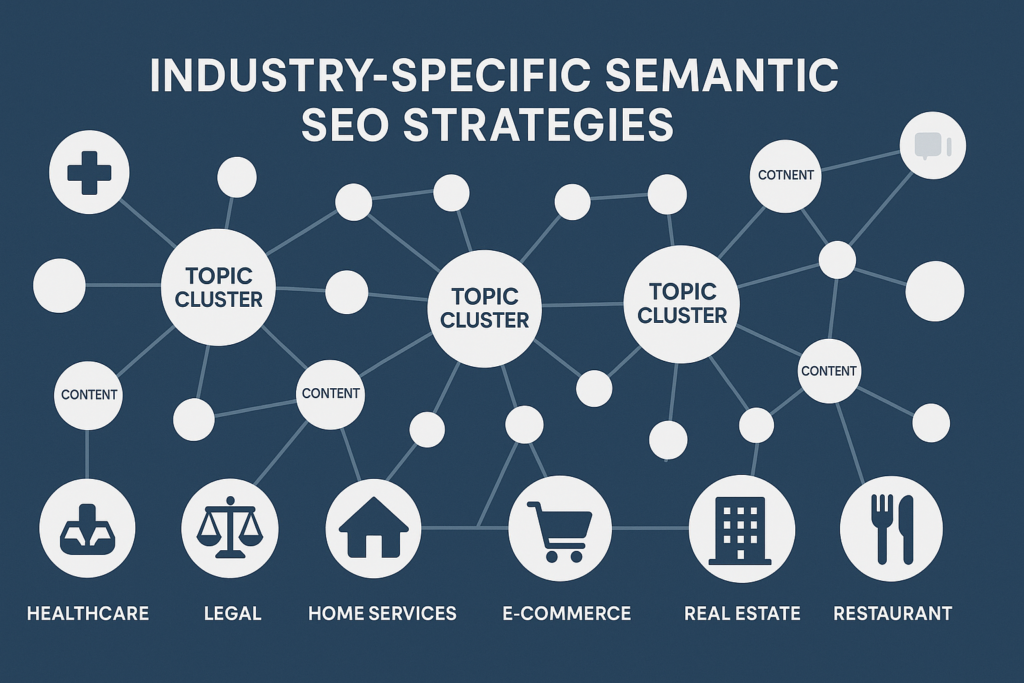The evolution of search engine algorithms has fundamentally transformed how businesses approach search engine optimization, moving far beyond simple keyword targeting toward sophisticated semantic understanding. Modern search engines now prioritize context, intent, and semantic relationships, making it essential for businesses across different industries to develop comprehensive topic clusters that align with their unique market dynamics and user behavior patterns. Every NJ SEO Expert recognizes that industry-specific semantic strategies require deep understanding of sector-specific terminology, user intent patterns, and content relationship structures.
This comprehensive guide explores how different industries can leverage semantic SEO principles to build authoritative topic clusters that drive organic visibility and user engagement. From healthcare practices managing complex medical terminology to restaurants optimizing for local cuisine searches, each industry presents unique challenges and opportunities in the semantic search landscape.

Industry-Specific Semantic SEO Complexity and Requirements Analysis
The complexity and requirements for semantic SEO vary dramatically across industries, as demonstrated in the analysis above. Understanding these variations enables businesses to allocate resources effectively and develop targeted strategies that align with their specific market characteristics and user expectations.
Table of Contents
ToggleUnderstanding Semantic SEO Fundamentals
Semantic SEO represents a paradigm shift from traditional keyword-focused optimization to meaning-based content strategy. This approach emphasizes understanding user intent, contextual relationships between concepts, and the creation of comprehensive content ecosystems that satisfy complex search queries. Any experienced SEO expert in New Jersey understands that semantic optimization requires mapping the relationships between entities, concepts, and user needs within specific industry contexts.
The foundation of semantic SEO lies in topic clustering, a content organization strategy that groups related content around central themes or pillar topics. This approach creates logical content hierarchies that both users and search engines can easily navigate and understand.

Topic Cluster Hub-and-Spoke Structure Model
The hub-and-spoke model illustrated above shows how topic clusters create interconnected content networks. The pillar page serves as the authoritative hub covering broad topics, while cluster pages dive deep into specific subtopics, all connected through strategic internal linking that reinforces topical authority and semantic relationships.
Modern search engines use natural language processing and machine learning to understand the context and relationships between different pieces of content. This means that businesses must think beyond individual keywords and consider how their content fits into broader topical ecosystems that address user needs comprehensively.

Semantic SEO Implementation Process Infographic
Search Intent Patterns Across Industries
Different industries exhibit distinct search intent patterns that directly influence semantic SEO strategy development. Understanding these patterns enables businesses to create content that aligns with how their target audiences naturally search for information, products, and services.

Search Intent Distribution Across Different Industries
The distribution of search intent types varies significantly across industries, reflecting fundamental differences in how users interact with different types of businesses. Healthcare and legal industries show higher informational intent, as users often seek educational content before making decisions. Home services and restaurants demonstrate higher transactional intent, reflecting immediate need fulfillment patterns.
These intent patterns directly influence content strategy and topic cluster development. Industries with high informational intent require deeper educational content and more comprehensive pillar pages, while transactional-focused industries benefit from streamlined content paths that quickly guide users toward conversion actions.
Healthcare SEO: Medical Terminology and Patient-Focused Content Clusters
Healthcare organizations face unique challenges in semantic SEO due to strict regulatory requirements, complex medical terminology, and diverse patient information needs. Every SEO Consultant in New Jersey working with healthcare clients must navigate the balance between medical accuracy and patient-friendly communication while building authoritative topic clusters.
Healthcare semantic SEO success depends on creating comprehensive content clusters around medical conditions, treatment options, prevention strategies, and patient care processes. These clusters must demonstrate expertise, authority, and trustworthiness while remaining accessible to patients with varying levels of medical knowledge.
The most effective healthcare topic clusters organize content around patient journeys, starting with symptom awareness and progressing through diagnosis, treatment options, and ongoing care management. For example, a dermatology practice might develop clusters around skin conditions, with pillar pages covering broad categories like acne, aging, or skin cancer, supported by detailed cluster pages addressing specific treatments, prevention methods, and patient testimonials.
Medical entity optimization requires careful attention to symptom-to-condition relationships, treatment-to-outcome connections, and provider-to-specialty associations. Search engines increasingly understand these medical relationships, rewarding content that accurately represents the connections between symptoms, diagnoses, and treatment options.
Patient-focused content clusters must address both the emotional and informational aspects of healthcare decisions. This includes creating content that acknowledges patient concerns, explains complex procedures in understandable terms, and provides clear guidance for next steps in the healthcare journey.
Legal SEO: Practice Area Semantic Relationships and Legal Query Patterns
Legal practices require sophisticated semantic SEO strategies that address complex legal procedures, practice area relationships, and client decision-making processes. The legal industry’s high-stakes nature means that potential clients often conduct extensive research before choosing representation, creating opportunities for comprehensive topic cluster development.
Legal semantic optimization centers on practice area specialization and the relationships between different legal procedures, case types, and client needs. A New Jersey SEO agency specializing in legal marketing understands that legal topic clusters must demonstrate both broad legal knowledge and deep expertise in specific practice areas.
Effective legal topic clusters organize content around client problems rather than legal technicalities. For instance, a personal injury law firm might create clusters around accident types, with pillar pages covering car accidents, workplace injuries, or medical malpractice, supported by cluster pages addressing specific scenarios, legal procedures, and case outcome factors.
Legal entity relationships include law-to-practice connections, case-type-to-procedure relationships, and jurisdiction-specific considerations. These relationships help search engines understand the firm’s expertise areas and connect relevant content to user queries about specific legal situations.
The legal industry’s seasonal patterns are generally minimal, but certain practice areas experience cyclical demand. Family law practices may see increased divorce inquiries after holidays, while tax attorneys experience seasonal surges during tax season. Understanding these patterns enables strategic content planning and resource allocation.
Home Services SEO: Service-Related Entity Optimization and Seasonal Search Patterns
Home services businesses face unique semantic SEO challenges due to strong seasonal variations, emergency service needs, and location-specific requirements. The industry’s local focus means that semantic optimization must incorporate geographic entities and seasonal service relationships effectively.
Home services semantic strategies revolve around problem-solution relationships, seasonal maintenance cycles, and service area coverage. These businesses must create topic clusters that address both preventive maintenance and emergency repair scenarios while optimizing for local search visibility.
Seasonal entity optimization becomes crucial for home services businesses, as search patterns vary dramatically throughout the year. HVAC companies experience peak demand during extreme weather seasons, while landscaping services see increased activity during growing seasons. A skilled semantic SEO specialist New Jersey understands how to create content clusters that capture these seasonal demand patterns.
Emergency services present unique semantic challenges, as users often search with urgent intent using conversational queries. Content clusters must address immediate problem-solving while also providing educational content about prevention and maintenance. For example, a plumbing company might create clusters around common plumbing issues, with emergency repair content supported by preventive maintenance guides and seasonal preparation tips.
Service area optimization requires careful attention to local entity relationships, including neighborhood-specific considerations, local climate factors, and regional building characteristics. These local entities help search engines understand service relevance for specific geographic areas and user locations.
E-commerce SEO: Product Taxonomy and Purchase Intent Modeling
E-commerce businesses require the most complex semantic SEO strategies due to vast product catalogs, diverse customer journey stages, and sophisticated purchase intent patterns. Product taxonomy development and semantic relationship mapping become critical for organizing large-scale content effectively.
E-commerce semantic optimization focuses on product-to-category relationships, feature-to-benefit connections, and use-case-to-product associations. These relationships help search engines understand product relevance for diverse user queries and shopping scenarios.
Product taxonomy development requires careful balance between broad category coverage and specific product differentiation. Successful e-commerce topic clusters organize products around user needs and shopping scenarios rather than internal business categories. For instance, an outdoor gear retailer might create clusters around activities (hiking, camping, climbing) rather than product types (clothing, equipment, accessories).
Purchase intent modeling involves understanding the semantic relationships between different query types throughout the customer journey. Educational content about product categories and use cases supports users in early research phases, while detailed product comparisons and reviews address users closer to purchase decisions.
Seasonal factors significantly impact e-commerce semantic strategies, with search patterns varying based on holidays, weather, and lifestyle changes. Understanding these seasonal entity relationships enables strategic content planning and inventory-focused optimization that aligns with natural demand cycles.
Real Estate SEO: Property-Related Semantic Networks and Market Terminology
Real estate businesses must navigate complex semantic relationships between properties, locations, market conditions, and buyer preferences. The industry’s local nature requires sophisticated geographic entity optimization combined with market-specific terminology and user intent understanding.
Real estate semantic strategies center on location-to-property relationships, market-to-pricing connections, and buyer-need-to-property-feature associations. These relationships help search engines understand property relevance for specific user requirements and geographic preferences.
Property-related topic clusters typically organize around location-based themes, with pillar pages covering neighborhoods, communities, or market areas, supported by cluster pages addressing specific property types, market analyses, and buyer guides. A New Jersey digital marketing expert working with real estate clients understands the importance of hyper-local content that addresses specific community characteristics and market dynamics.
Market terminology optimization requires careful attention to industry-specific language while maintaining accessibility for first-time buyers. Content must balance professional market insights with educational information that helps users understand complex real estate processes and terminology.
Geographic entity optimization becomes critical for real estate success, as location relevance directly impacts search visibility and user engagement. This includes optimizing for neighborhood names, school districts, transportation access, and local amenities that influence property decisions.
Restaurant SEO: Food and Cuisine-Based Topic Modeling
Restaurant businesses require semantic SEO strategies that address cuisine types, dining experiences, and local food culture while optimizing for immediate location-based needs. The industry’s emphasis on experiential and sensory content creates unique opportunities for semantic relationship development.
Restaurant semantic optimization focuses on cuisine-to-dish relationships, ingredient-to-recipe connections, and dining-experience-to-occasion associations. These relationships help search engines understand restaurant relevance for specific dining preferences and occasions.
Food-based topic clusters organize around cuisine types, dining experiences, and occasion-specific needs. Pillar pages might cover broad cuisine categories or dining concepts, supported by cluster pages addressing specific dishes, ingredients, dietary restrictions, and special events. Menu-related content requires careful optimization for both search engines and user experience, balancing SEO considerations with appetizing descriptions.
Local food culture optimization requires understanding regional preferences, seasonal ingredients, and community dining traditions. This local entity optimization helps restaurants connect with their specific geographic market while addressing broader cuisine-related searches.
Seasonal menu optimization presents ongoing semantic opportunities, as restaurants adapt offerings based on ingredient availability, holiday celebrations, and seasonal dining preferences. These seasonal entity relationships enable strategic content planning that aligns with natural demand patterns and culinary trends.
Implementation Strategy and Best Practices
Successful industry-specific semantic SEO implementation requires systematic approach to topic cluster development, entity relationship mapping, and content optimization. The process begins with comprehensive industry analysis to understand unique semantic relationships and user behavior patterns within specific business contexts.
Content audit and gap analysis help identify existing content assets and opportunities for semantic relationship development. This analysis should examine current content performance, identify missing topic areas, and evaluate semantic relationship strength between existing content pieces.
Entity mapping involves identifying and documenting the key entities, concepts, and relationships that define industry-specific semantic networks. This mapping process creates the foundation for topic cluster development and internal linking strategies that reinforce semantic relationships.
Technical implementation requires attention to structured data markup, internal linking architecture, and content organization that supports semantic understanding. These technical elements help search engines recognize and leverage the semantic relationships built into content strategy.
Performance monitoring and optimization involve tracking semantic keyword performance, topic cluster engagement metrics, and conversion outcomes across different industry-specific content areas. This data-driven approach enables continuous refinement of semantic strategies based on actual user behavior and search engine response.
Conclusion: Building Industry Authority Through Semantic Excellence
Industry-specific semantic SEO represents the future of search engine optimization, requiring businesses to move beyond keyword tactics toward comprehensive content ecosystems that demonstrate true expertise and authority. Each industry presents unique challenges and opportunities for semantic optimization, from healthcare’s regulatory complexity to e-commerce’s scale challenges.
The most successful businesses will be those that invest in understanding their industry’s specific semantic relationships, user intent patterns, and content requirements. This investment in semantic excellence creates sustainable competitive advantages that compound over time as search engines become increasingly sophisticated in understanding and rewarding comprehensive topical authority.
By developing industry-specific topic clusters, optimizing semantic relationships, and creating content that genuinely serves user needs, businesses can build lasting search visibility that adapts to evolving search algorithms while maintaining relevance for their target audiences. The future belongs to businesses that embrace semantic thinking and create content ecosystems that demonstrate true industry expertise and authority.

